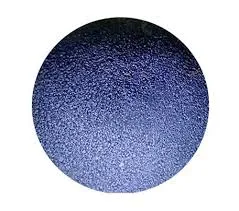Exploring the Properties and Applications of China Sulphur Black BR 220 Dye in Various Industries
The Significance of China Sulphur Black BR 220 in the Textile Industry
In the world of textiles, coloration is a crucial aspect that influences the appeal and marketability of various fabric types. Among the myriad of dyes available, Sulphur Black BR 220 stands out as a prominent option, particularly in the context of the Chinese textile sector. This synthetic dye has gained recognition for its deep, rich black coloration, excellent fastness properties, and versatility across multiple fabric types, including cotton, polyester, and blends.
The Composition and Properties of Sulphur Black BR 220
Sulphur Black BR 220 is a synthetic dye that belongs to the class of sulfur dyes. These dyes are characterized by their ability to form complex compounds that can easily bond with fibers, resulting in vibrant and long-lasting colors. The chemical structure of Sulphur Black BR 220 allows it to provide an intense black shade that is highly sought after in various textiles, especially in denim and heavy-duty fabrics. One of the key advantages of this dye is its remarkable wash and lightfastness, which means the color remains stable even after multiple washes or prolonged exposure to sunlight.
Moreover, Sulphur Black BR 220 is cost-effective, making it an attractive choice for manufacturers seeking both quality and affordability. The dye can be processed through a range of applications and can be used in dyeing, printing, and even for creating specialized textile effects. This versatility makes it suitable for an array of products, from fashionable apparel to durable home textiles.
Environmental Considerations and Innovations
china sulphur black br 220

As with many synthetic dyes, the production and use of Sulphur Black BR 220 have raised environmental concerns, particularly regarding wastewater management and chemical disposal. In recent years, the textile industry has become increasingly aware of its environmental impact, and manufacturers in China are seeking to make strides towards more sustainable practices. Innovations in the dyeing process, including the use of closed-loop systems that recycle water and minimize waste, are being explored to reduce the ecological footprint associated with Sulphur Black BR 220.
Furthermore, efforts are underway to develop eco-friendly alternatives and improve the overall sustainability of textile production. Some manufacturers are working with biodegradable Sulphur dyes and adhering to strict environmental regulations to ensure that their operations do not harm the ecosystem. These innovations not only address environmental concerns but also appeal to a growing base of environmentally-conscious consumers.
Market Trends and Future Outlook
The demand for Sulphur Black BR 220 has been bolstered by the rapid growth of the fashion and apparel industry, particularly in emerging markets. As consumer preferences shift towards darker shades and unique textile finishes, Sulphur Black BR 220 is poised to play an essential role in fulfilling these demands. Additionally, its application in technical textiles and industrial fabrics further expands its market potential.
Looking ahead, the future of Sulphur Black BR 220 in the Chinese textile industry appears promising. With continuous advancements in dye technology, improved sustainability practices, and an ever-growing market for versatile and durable fabrics, Sulphur Black BR 220 will remain a vital component in the development of innovative textile solutions.
In conclusion, China Sulphur Black BR 220 is more than just a dye; it embodies the intersection of quality, cost-effectiveness, and evolving sustainability in the textile industry. As manufacturers adapt to changing market dynamics and consumer preferences, this dye continues to hold significant value in shaping the future of textile coloration.
-
The Timeless Art of Denim Indigo Dye
NewsJul.01,2025
-
The Rise of Sulfur Dyed Denim
NewsJul.01,2025
-
The Rich Revival of the Best Indigo Dye
NewsJul.01,2025
-
The Enduring Strength of Sulphur Black
NewsJul.01,2025
-
The Ancient Art of Chinese Indigo Dye
NewsJul.01,2025
-
Industry Power of Indigo
NewsJul.01,2025
-
Black Sulfur is Leading the Next Wave
NewsJul.01,2025

Sulphur Black
1.Name: sulphur black; Sulfur Black; Sulphur Black 1;
2.Structure formula:
3.Molecule formula: C6H4N2O5
4.CAS No.: 1326-82-5
5.HS code: 32041911
6.Product specification:Appearance:black phosphorus flakes; black liquid

Bromo Indigo; Vat Bromo-Indigo; C.I.Vat Blue 5
1.Name: Bromo indigo; Vat bromo-indigo; C.I.Vat blue 5;
2.Structure formula:
3.Molecule formula: C16H6Br4N2O2
4.CAS No.: 2475-31-2
5.HS code: 3204151000 6.Major usage and instruction: Be mainly used to dye cotton fabrics.

Indigo Blue Vat Blue
1.Name: indigo blue,vat blue 1,
2.Structure formula:
3.Molecule formula: C16H10N2O2
4.. CAS No.: 482-89-3
5.Molecule weight: 262.62
6.HS code: 3204151000
7.Major usage and instruction: Be mainly used to dye cotton fabrics.

